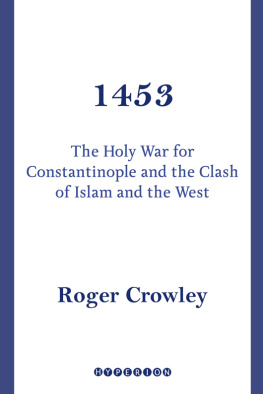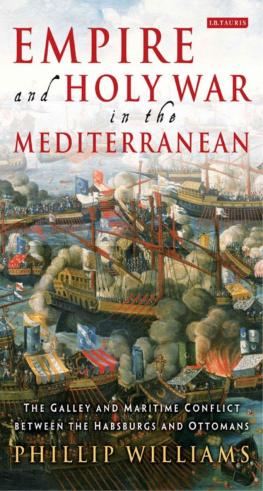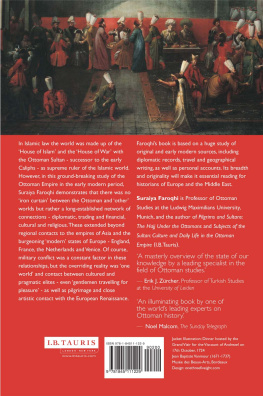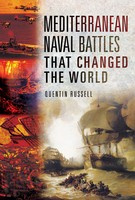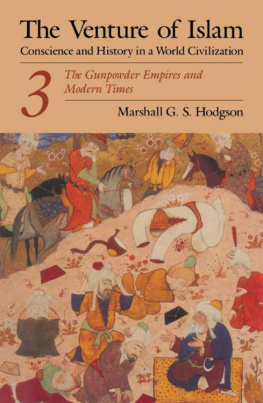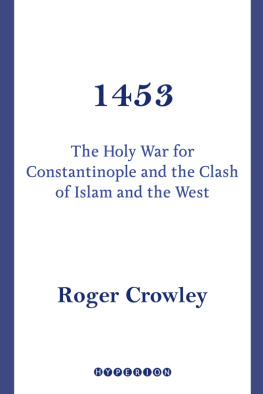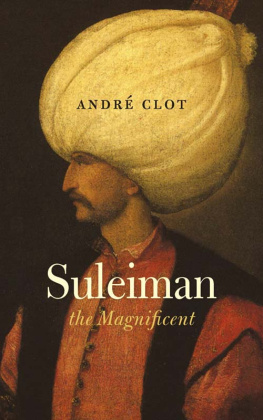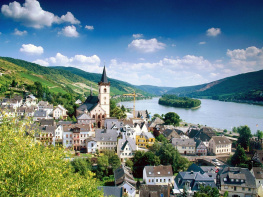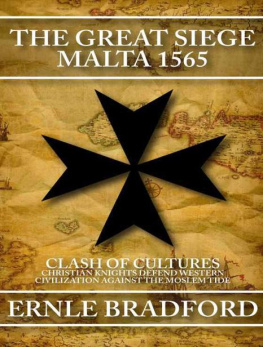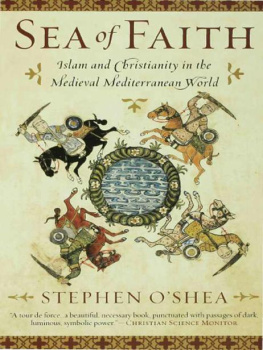
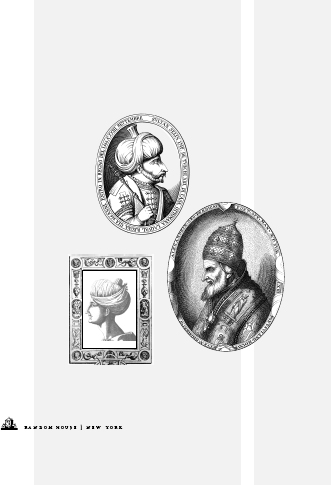
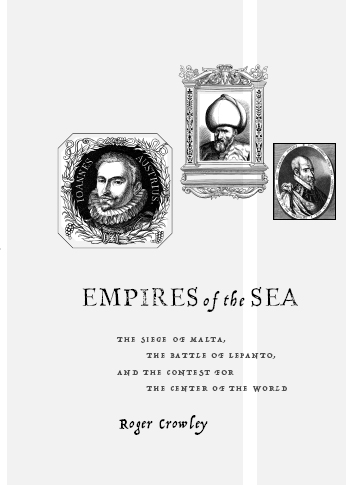
Contents
AUTHORS NOTE AND
ACKNOWLEDGMENTS
To George,
who also fought in this sea, and who took us there
The inhabitants of the Maghreb have it on the authority of the book of predictions that the Muslims will make a successful attack against the Christians and conquer the lands of the European Christians beyond the sea. This, it is said, will take place by sea.
IBN KHALDUN, FOURTEENTH-CENTURY ARAB HISTORIAN
PROLOGUE
Ptolemys Map
L ONG BEFORE THE OFFICE BLOCKS across the Golden Horn, before even the mosques, there was the church. The dome of Saint Sophia stood alone against the skyline for a thousand years. If you had made your way up onto its roof anytime in the Middle Ages, you would have been afforded an unimpeded view of the city garlanded by water. From here it is quite clear why Constantinople once ruled the world.
On the afternoon of May 29, 1453, Mehmet II, sultan of the Ottoman Empire, made this ascent. It was the end of a momentous day. His army had just taken the city by storm in fulfillment of Islamic prophecy and destroyed the last vestiges of the Christian empire of Byzantium. Mehmet climbed, in the words of the Ottoman chronicler, as the spirit of God ascending to the fourth sphere of heaven.
The sultan gazed upon a scene of melancholy devastation. Constantinople had been wrecked and thoroughly looted, despoiled and blackened as if by fire. The citys army had been routed, the churches ransacked; its last emperor had perished in the massacre. Long lines of men, women, and children were being roped together and herded off. Flags fluttered from empty buildings, a sign to looters that the spoils had already gone. Above the pitiful wailing of the captives, the call to prayer rose in the spring air. It signaled the emphatic end of one imperial dynasty, the legitimization of another by right of conquest. The Ottoman Turks, a nomadic, tribal people from the heart of Asia, had now consolidated the presence of Islam on the European shore in the city they called Istanbul. Its capture confirmed Mehmet both as heir to Byzantium and as the undisputed leader of holy war.
From his vantage point the sultan could contemplate the past and future of the Turkish people. To the south, beyond the Bosphorus straits, lay Anatolia, Asia Minor, the road up which the Turks had made their long migration; to the north, Europe, the object of their territorial ambitions. But it was the prospect to the west that was to prove most challenging to the Ottomans. In the afternoon sun, the Sea of Marmara glittered like beaten brass; beyond lay the wide expanse of the Mediterranean, the place the Turks called the White Sea. With the conquest of Byzantium, Mehmet was not just inheriting a landmass; he was also heir to a maritime empire.
THE EVENTS OF 1453 were part of a larger ebb and flow in the struggle between Islam and Christianity. Between the eleventh and the fifteenth centuries, Christendom, on the impetus of the Crusades, had dominated the Mediterranean. It had created a patchwork of small states on the shores of Greece and the islands of the Aegean, which linked the enterprise of crusading to the Latin West. The direction of conquest had begun to reverse when the Crusaders lost their last major foothold on the shores of Palestine in 1291 at the fall of Acre. Now Islam was poised to strike back.
No one since the Romans had possessed sufficient resources to organize this sea, but Mehmet conceived himself as the inheritor of the Roman emperors. His ambitions were limitless. He was determined to create one empire, one faith and one sovereignty in the world, and he styled himself the sovereign of two seasthe White and the Black. This was alien territory for the Ottomans. The sea is not solid ground. There are no natural frontiers, nowhere for nomads to pitch camp. It is uninhabitable. It remembers nothing: Islam had established footholds in the Mediterranean before and then lost them. But Mehmet had already set down a clear declaration of intent: he brought a large, if inexperienced, fleet to the siege of Constantinople, and the Ottomans were quick learners.
In the years after the conquest, Mehmet commissioned a copy of a map of Europe by the ancient geographer Ptolemy, translated for him into Arabic by Greeks. Here he studied the configuration of the sea in predatory detail. He ran his finger over Venice, Rome, Naples, Sicily, Marseilles, and Barcelona; he traced the Gates of Gibraltar; even faraway Britain fell under his gaze. The translators had prudently ensured that nowhere was marked as prominently as Istanbul, and Mehmet was as yet unaware that the Catholic kings in Spain were in the process of constructing a matching set of imperial ambitions at the maps western edge. Madrid and Istanbul, like giant mirrors reflecting the same sun, were initially too far apart to be mutually visible. Soon hostility would focus the light. Even Ptolemys map, with its unfamiliar misshapen peninsulas and distorted islands, could not conceal an essential fact about the Mediterranean: it is really two seas, pinched at the middle by the narrow straits between Tunis and Sicily, with Malta sitting midstream, an awkward dot. The Ottomans would quickly dominate the eastern seas, the Hapsburgs of Spain the western. In time both would converge on the dot.
NOWADAYS YOU CAN FLY the length of the Mediterranean, from southern Spain to the shores of Lebanon, in three hours. From the air it is a peaceful prospect; the orderly procession of ships moves tamely over the glittering surface. The thousands of miles of crenellated coast on the northern shore reveal holiday villages, yacht harbors, and smart resorts, as well as the great ports and industrial complexes that provide the economic muscle of Southern Europe. Every vessel in this calm lagoon can be tracked from space. Ships travel at will, immune to the storms that wrecked Odysseus and Saint Paul. To our ever-shrinking world the place the Romans called the center of the world seems tiny.
Five hundred years ago people experienced the sea quite differently. Its shores were coasts of hunger, stripped early of trees, then soil, by men and goats. By the fourteenth century, Crete was able to furnish Dante with an image of ecological ruin. In mid-sea sits a waste land, he wrote, which once was happy with water and leaves. Now it is a desert. The sea is also barren. The Mediterranean has been formed by dramatic geological collapse, so that the entrancing transparent waters at its edge plunge away sharply into deep submarine gulfs. There are no continental platforms to rival the rich fishing grounds of Newfoundland or the North Sea. To those living on the shore, the million square miles of water, broken up into a dozen separate zones, each with its own particular winds and coastal irregularities and scattered islands, were intractable, vast, and dangerousso big that the two halves of the Mediterranean were different worlds. A sailing ship might take two months to make the voyage from Marseilles to Crete in good weather, in bad six. Boats were surprisingly unseaworthy, storms sudden, pirates numerous, so that sailors generally preferred to creep around the seas coastal margins rather than cross open water. Peril attended the voyage: no sane person would step up the gangplank without committing his soul to God. The Mediterranean was a sea of troubles. And after 1453 it became the epicenter of a world war.
Next page

